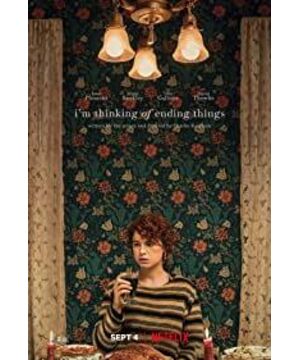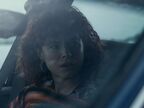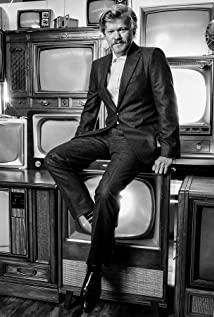Charlie Kaufman's new work "I Want to End It All" inherits the gray and desperate emotional tone of his old work "Disorder" and the time jump of "New York Synonymy", but to be precise, this work is more like a Resnais 's work, showing the memory labyrinth of the real protagonist, the cleaner.
Before the end of the school sequence, the viewer sees the narrative point of view from the heroine, who drives to Jack's house with her boyfriend Jack, has dinner with Jack's parents, and then goes to the ice cream shop and Jack's school. During this journey, Charlie Kaufman hints at the truth that the original male and female protagonists are the imaginary personalities of the cleaners through various clues - including direct insertion of cleaners watching musical rehearsals at school, mopping floors , watching TV and other clips (the elements in these clips also appear more or less in the journey of the male and female protagonists), and the female protagonist finds her childhood photos in the male protagonist's house, the cleaner's uniform, the two's Discussion blah blah blah - and the way this thread is inserted, along with the film's retro frame and tone, makes the first half of the film feel very close to The Shining-style psychological horror on first viewing. The heroine has been trying to "end all this" before, as the incarnation of the ideal girlfriend of the cleaner, and also the reflection of his self-denial, to question Jack, another projection of the cleaner, just as his girlfriend received many times in the play. The call that arrived (also the cleaner's consciousness) said: "There's only one problem to fix, I'm scared, I feel a little crazy, I'm not crazy, how... those assumptions are right, I can feel the growing Fear, it's time for an answer, just one question, one question that needs to be answered." This question will be answered at the end of the curtain, which is the end of the two's journey. How to end all this?
After the two left home (yellow-green tone) and rushed to school, the two passages of the road and the ice cream shop were completely surrounded by blue and black. At this time, the tone was obviously unrealistic and thriller. When the heroine When entering the school to find Jack, the light in the school is still gloomy, but more realistic than before. It should be said that before the heroine met the cleaner, the long shot when entering the school still adopted a thriller-style shooting method. First, follow the heroine from the darkness at the door and enter under the incandescent tube. After the heroine's figure becomes clear from the darkness, the cleaner flashes in the distance and changes the movement of the camera and the heroine at the same time—— The heroine hides sideways behind the door. The camera moves forward from the middle of the corridor and keeps a medium shot, and turns to shoot a close-up shot of the heroine in a circle. When the camera circles around the heroine, the heroine walks out from behind the door and continues to move forward. Follow in front of the heroine and turn to shoot the front of the heroine. At the same time, it is worth noting that the darkness in this long shot always occupies a large part of the picture. The first half of the heroine is in the dark, and the second half of the heroine walks into the light, but the darkness behind her is still clearly visible. .
After that, the heroine avoids the figure of the cleaner like a horror movie monster, which once again emphasizes the heroine's role as a cleaner's self-denial and disgust. And the image of the real subject of the cleaners, from a blurred (horror) figure in the distance, to a close-up shot in a low-level position (finding the heroine squatting behind the door and talking to the heroine), to normal The close-up of the camera position (talking to the female protagonist who stood up), and at the same time, after a few front and back shots, the black shadow area on the cleaner's face is constantly shrinking (although the position has not changed), all from the visual language. Reflecting the awakening and clarification of the subject of the cleaner, he will take over the role of the narrator of the heroine and "end it all" with his true self. In the dialogue, the female protagonist directly expressed her disgust for the male protagonist Jack, "He is a weirdo." Then she gave the cleaner a thank-you, friend-like hug to bid him farewell, and rejected the shoes handed by the cleaner. The cleaner finally realized that the heroine, the ideal girlfriend imagined by him, will bid farewell to him, or that a person like him can only be a friendly listener and get a hug without affection.
Afterwards, the heroine and the hero met in the corridor of the school, and began a symbolic dance paragraph that can be said to be the summary of the sense of the plot. A more idealized, handsome and beautiful hero and heroine flashed from behind the hero and heroine respectively (it can be seen from the dress that they were them), the two ran to each other and danced (this is obviously echoing the previous The corridor saw a scene of a boy and a girl practicing dance), with the flash of light, the original male and female protagonists disappeared, and the brightness of the picture also increased, it looked like it was daytime, and then under the high brightness, the two were cheerful They danced, and a priest appeared silently to witness their marriage. Just when the ideal version of the male protagonist lifted his veil and was about to kiss the ideal version of the female protagonist, a man in a cleaner's uniform appeared, pushed the ideal version of the male protagonist away, and the light The brightness dropped sharply, and the cleaners chased after the ideal heroine to the gym. It was snowing heavily in the gym, the cleaners fought with the ideal version of the male protagonist and stabbed him to death, and dragged the ideal version of the female protagonist away (this paragraph is presented with silent dance throughout). At this time, the male and female protagonists came to the body of the ideal version of the male protagonist, turned around and left in different directions. The real cleaner showed up, swept the snow around the body, shot everything, and returned to the normal school corridor, still dragging the floor. The narrative perspective officially came to the cleaners. And this passage directly expresses the self-loathing of the cleaner by "self" (the man in the cleaner's uniform in the dance drama): First, he believes that only the idealized self is worthy of idealized love, the real self It is so ugly that he is not worthy of his imaginary girlfriend; secondly, he does not want to indulge in fantasy and memory, so in the play he stabs his idealized self to death. Start picking up the pieces.
In the end, we watched the cleaners work and clean up in the normal color tone and light closest to reality, got into our car in the snow, put down the keys, did not start, but sat quietly, driving, parents quarreling (again implying that Jack's parents are the cleaner's parents) etc. flashbacks, the camera starts to cut and shake a lot, and we see the cleaner take off all his clothes while crying. The camera then turns to the cleaner's subjective perspective. A black-and-white promotional animation of an ice cream shop appears on the front windshield of the car (echoing the paragraph where the male and female owners drive to the ice cream shop and the trash can in front of the school is full of empty ice cream buckets), This ice cream shop, which is open day and night, seems to be the only consolation for the cleaners, which can also be reflected from the male protagonist Jack's previous insistence on going there and his dialogue with the female protagonist. After the ad ended, the camera shot back quickly, giving a cleaner's reaction shot, and at the same time, the brightness increased, as if from night to day, and returned to the cleaner's perspective (the previous shot was the cleaner's subjective perspective, the shot here is Shot from the back of the cleaner's head), we see that the cleaner's naked head and neck is in the foreground, and an animated pig appears on the windshield in the rear (obviously echoing the story of the farmer's story about his own house) The pig that was eaten alive by maggots because it had not been taken care of for a long time), the colors of the two are very similar. The pig called for the cleaner, and the cleaner got out of the car and followed the pig to walk naked in the snow back to school. In this passage, the pig said the cleaner's "relax" (or give up the fantasy) "Once you are no longer because you are a pig, or worse, a pig full of maggots, and it's not that bad, someone has to be a pig full of maggots, right?" At the end of the hallway and dialogue, the animated pig disappears . The camera turned to a large auditorium, and the elderly version of the male protagonist Jack delivered his acceptance speech on stage, and all the audience off the field wore extremely exaggerated elderly makeup. Accompanied by the sensational background music, Jack made a "Nolan" statement: "Only in the mysterious equation of love can logic be found." Then he began to sing the musical (again with the previous The cleaners watch the rehearsal of a student musical), singing all his wishes: "The girl I want isn't afraid of my arms..." And the real reality: "The floor creaks, the door creaks Ring, a mouse starts gnawing on a broom, the sun flickers my eyes, it's all a lie, I wake up in a lonely room..." But despite his desire to start living, despite his singing: "I don't want to dream of her arms anymore, I don't want to leave her alone, go outside, find a bride for myself..." But as the audience applauded, this The fantasy paragraph is also over, the blue light flashes, and the cleaner's car is seen outside, which has been completely buried by the heavy snow. This is the end of the play.
The final scene of the film is a tragedy of the "little match girl" style. The cleaner gave up his fantasy and prepared to commit suicide, but before he died, he saw the vision again, and a lot of previous passages and images were re-referenced here. At the same time, due to the transfer of the status of the heroine narrator, the film is no longer a new French novel or an Alain Renais-style memory palace, and the audio-visual aspects such as tone are gradually closer to the realism, from horror films to musical films to inspirational films. Finally ushered in the clear morning after the snowy night and the death of the cleaner. By the heroine's mouth, he was always hesitating, "I want to end all this", but the hero Jack is trying his best to keep him, how much he wants to get everything he wants, as a man who has read poetry and books and has been involved in a wide range (before that) His profound knowledge is reflected in the passages of the hero and heroine) but he can only be a loser as a cleaner in a broken school. His life is undoubtedly full of failures, which makes him have to fail in his imagination (the heroine keeps going question the hero). Imagining the failure of this sustenance made him simply "kill" the male protagonist in the dance drama, leave the fantasy, enter the car and prepare to commit suicide, but all the failures flashed before his eyes again, he is still not reconciled, he is the raw maggot At the end of his life, he fantasizes that he is recognized by everyone. As long as he can do this, he can have the courage to step out of the fantasy, go to a real life, and find his real love. But the reality is that he died in the car, the reality is that he is alone from beginning to end, and the only thing he communicates with the cleaner in the whole film is his fantasy.
He ended it all, the only correct answer to the only question. And the reality is clear, no one cares what's under the snow.
View more about I'm Thinking of Ending Things reviews











